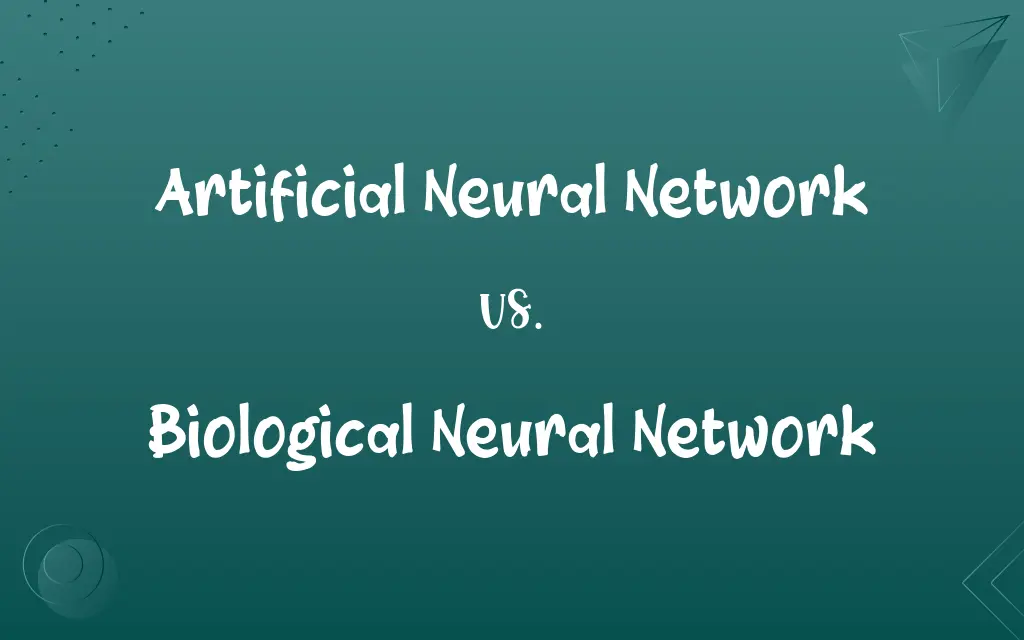Artificial Neural Network vs. Biological Neural Network: Know the Difference

By Shumaila Saeed || Published on February 20, 2024
Artificial Neural Networks are computational models inspired by the human brain, used for tasks like pattern recognition, while Biological Neural Networks consist of real neurons in living organisms, processing sensory, motor, & cognitive information.

Key Differences
Artificial Neural Networks (ANNs) are computer-based systems that mimic the way biological neural networks work. They are composed of interconnected units (nodes) that process information using a connectionist approach to computation. Biological Neural Networks, on the other hand, are made up of actual biological neurons, connected through synapses, and are responsible for processing and transmitting information in living organisms.
Shumaila Saeed
Feb 20, 2024
ANNs learn from data and adjust their processing by changing the weights of connections between nodes, using algorithms like backpropagation. This learning is based on data patterns and is often used for tasks like image and speech recognition. Biological Neural Networks learn through a process known as synaptic plasticity, where the strengths of synaptic connections are adjusted based on experience and neural activity, crucial for memory and learning.
Shumaila Saeed
Feb 20, 2024
In ANNs, the structure and functionality are simplified abstractions of biological networks, designed for efficiency in specific tasks. They do not replicate the full complexity of biological neural networks, which consist of a vast array of different types of neurons, each with unique properties, and are capable of more complex, holistic processing.
Shumaila Saeed
Feb 20, 2024
The speed of processing in ANNs is dependent on computational power and can be incredibly fast, but lacks the adaptability and parallel processing capabilities of biological neural networks. Biological networks, while slower in signal transmission, can perform complex, parallel processing, making them more efficient for certain types of information processing.
Shumaila Saeed
Feb 20, 2024
ANNs are primarily used in machine learning and artificial intelligence for solving complex problems in various fields, from medicine to finance. Biological Neural Networks, however, are integral to the functioning of living organisms, enabling responses to environmental stimuli, conscious thought, and bodily functions.
Shumaila Saeed
Feb 20, 2024
ADVERTISEMENT
Comparison Chart
Learning Process
Adjusts connections based on data patterns.
Synaptic plasticity based on experience.
Shumaila Saeed
Feb 20, 2024
Structure and Function
Simplified abstraction, task-specific.
Complex, diverse types of neurons.
Shumaila Saeed
Feb 20, 2024
Processing Speed
Dependent on computational power, often fast.
Slower, but efficient in parallel processing.
Shumaila Saeed
Feb 20, 2024
Primary Use
Machine learning, artificial intelligence applications.
Essential for organism functions, cognition.
Shumaila Saeed
Feb 20, 2024
ADVERTISEMENT
Artificial Neural Network and Biological Neural Network Definitions
Artificial Neural Network
An ANN consists of layers of interconnected nodes processing information.
The ANN diagnosed medical conditions by analyzing patient data.
Shumaila Saeed
Jan 23, 2024
Biological Neural Network
A biological neural network conducts signals through synaptic connections.
The biological neural network initiated a response to the sudden sound.
Shumaila Saeed
Jan 23, 2024
Artificial Neural Network
An Artificial Neural Network is a computational model inspired by biological brain networks.
An ANN was used to predict stock market trends.
Shumaila Saeed
Jan 23, 2024
Biological Neural Network
It's composed of a variety of neuron types, each with unique functions.
The biological neural network in the visual cortex processed visual stimuli.
Shumaila Saeed
Jan 23, 2024
Artificial Neural Network
It's a machine learning tool that learns from large datasets.
The ANN improved its language translation accuracy over time.
Shumaila Saeed
Jan 23, 2024
ADVERTISEMENT
Biological Neural Network
A Biological Neural Network consists of interconnected neurons in living organisms.
The biological neural network processed the sensory input from the environment.
Shumaila Saeed
Jan 23, 2024
Artificial Neural Network
ANNs simulate the decision-making process of the human brain.
An ANN was employed to navigate autonomous vehicles.
Shumaila Saeed
Jan 23, 2024
Biological Neural Network
It's the brain's network, responsible for thought, emotion, and motor control.
The biological neural network enabled the athlete to react quickly during the game.
Shumaila Saeed
Jan 23, 2024
Artificial Neural Network
It's a network of artificial neurons programmed to recognize patterns.
The ANN accurately identified faces in a crowd.
Shumaila Saeed
Jan 23, 2024
Biological Neural Network
This network adapts and learns through synaptic plasticity.
The biological neural network adapted to new languages through sustained practice.
Shumaila Saeed
Jan 23, 2024
Repeatedly Asked Queries
How do ANNs learn?
ANNs learn by adjusting connection weights based on data patterns.
Shumaila Saeed
Feb 20, 2024
What is synaptic plasticity in Biological Neural Networks?
It's the process where synaptic connections adjust based on experience.
Shumaila Saeed
Feb 20, 2024
How fast do ANNs process information?
They process data rapidly, depending on computational power.
Shumaila Saeed
Feb 20, 2024
Are Biological Neural Networks capable of parallel processing?
Yes, they efficiently perform complex parallel processing.
Shumaila Saeed
Feb 20, 2024
What are some applications of ANNs?
They're used in AI, machine learning, image recognition, and more.
Shumaila Saeed
Feb 20, 2024
Are ANNs used in robotics?
Yes, they're often used in robotics for pattern recognition and decision-making.
Shumaila Saeed
Feb 20, 2024
Can ANNs operate independently of human input?
They require initial programming but can operate independently afterward.
Shumaila Saeed
Feb 20, 2024
How are ANNs and Biological Neural Networks similar?
Both process information through a network of interconnected units.
Shumaila Saeed
Feb 20, 2024
Can ANNs replicate the full complexity of Biological Neural Networks?
No, ANNs are simplified models and don't replicate the full complexity.
Shumaila Saeed
Feb 20, 2024
How does a Biological Neural Network contribute to organism functions?
It's essential for cognitive functions, responses to stimuli, and bodily control.
Shumaila Saeed
Feb 20, 2024
What is an Artificial Neural Network?
It's a computer-based system mimicking biological neural networks for data processing.
Shumaila Saeed
Feb 20, 2024
What makes up a Biological Neural Network?
It consists of interconnected neurons in living organisms.
Shumaila Saeed
Feb 20, 2024
Are ANNs able to emulate human emotions?
No, they lack the capability to replicate human emotions.
Shumaila Saeed
Feb 20, 2024
How does aging affect Biological Neural Networks?
Aging can lead to a decline in efficiency and functionality.
Shumaila Saeed
Feb 20, 2024
Are ANNs evolving?
Yes, they're continuously evolving with advances in technology and research.
Shumaila Saeed
Feb 20, 2024
Is the human brain an example of a Biological Neural Network?
Yes, it's a complex and advanced biological neural network.
Shumaila Saeed
Feb 20, 2024
Do ANNs require maintenance?
They require updates and tuning to maintain efficiency.
Shumaila Saeed
Feb 20, 2024
Do Biological Neural Networks function slower than ANNs?
Yes, in terms of signal transmission, but they're more efficient in some processes.
Shumaila Saeed
Feb 20, 2024
What's a key difference in learning between ANNs and Biological Neural Networks?
ANNs use algorithmic learning, while biological networks use synaptic plasticity.
Shumaila Saeed
Feb 20, 2024
Can Biological Neural Networks repair themselves?
To some extent, through neuroplasticity and healing processes.
Shumaila Saeed
Feb 20, 2024
Share this page
Link for your blog / website
HTML
Link to share via messenger
About Author
Written by
Shumaila SaeedShumaila Saeed, an expert content creator with 6 years of experience, specializes in distilling complex topics into easily digestible comparisons, shining a light on the nuances that both inform and educate readers with clarity and accuracy.









































































